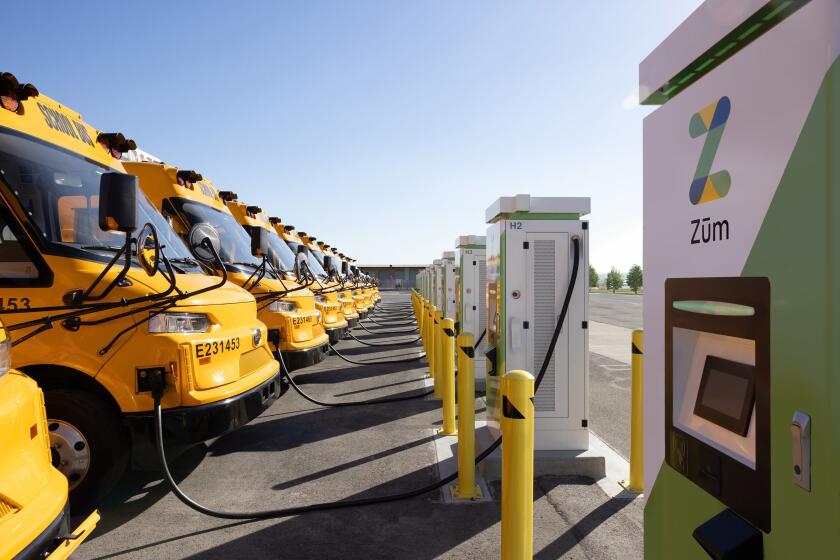$132-Million Belmont Pact Sought
First they found the explosive methane gas. Then it was the earthquake fault line under the half-built high school. Twice they have tried to finish Belmont Learning Complex. Twice it has been abandoned.
Now, eight years and about $175 million after construction first started, the deeply troubled downtown campus is again on the verge of resurrection.
For the record:
12:00 a.m. Nov. 18, 2005 For The Record
Los Angeles Times Friday November 18, 2005 Home Edition Main News Part A Page 2 National Desk 2 inches; 81 words Type of Material: Correction
School location -- A map in Tuesday’s California section with an article about Los Angeles schools Supt. Roy Romer’s plans to ask the Board of Education to approve a construction contract for a new high school gave the wrong location for Vista Hermosa (formerly the Belmont Learning Complex). The location shown on the map is that of the existing Belmont High School, 1575 W. 2nd St. The Vista Hermosa project is on the northwest corner of 1st Street and Beaudry Avenue.
Today, Los Angeles schools Supt. Roy Romer will ask the Board of Education to approve a $132-million construction contract to complete a scaled-back version of the school. Using outdated estimates that did not fully account for the dramatic rise in the price of building materials, district officials had expected construction costs to be about $40 million less.
All told, including new design, inspection and equipment costs, the final cost is expected to approach $350 million. It is believed to be the nation’s most expensive public school.
A divided school board, which agreed to finish the troubled campus in 2003, is expected to vote next week on the construction contract.
The staggering figures, and an unusual plan to use money from developer fees to pay for the school, have rekindled long-running concerns over the wisdom of pursuing the project.
“Could we knock this thing down, sell 15 acres and build a smaller high school? How much would that cost?” asked board member David Tokofsky. “I’d certainly like to know what reasonable alternatives were thought of.”
During its lengthy history, Belmont became synonymous with district bungling and bureaucracy. The land, atop an oil field, was hastily purchased in the early 1990s without thorough environmental testing.
The discovery of explosive methane and hydrogen sulfide vapors in 1999 led to a slew of lawsuits and investigations. Several high-ranking Los Angeles Unified School District staff members were sharply criticized, with one report calling their oversight, “ad hoc, uninformed by reference to any policy and generally rudderless.”
In the midst of his investigation, Los Angeles County Dist. Atty. Steve Cooley called the site a “crime scene,” although he never filed charges.
Romer, who gazes down on the unsightly campus from his office, has made it a priority to salvage the project since being hired five years ago. The school and two other future campuses nearby are all needed to relieve severe crowding in the downtown area, he says.
He maintains that even if the district could find a new location for the school, it would cost more to abandon the project and start fresh.
District officials estimate that a similarly sized school in downtown would cost roughly $200 million today.
But, for Romer, it is about more than building desk space.
“For 10 years this has symbolized the failures of this district,” he said. “We need to finish this because we need the seats, but we also need to remove this scar from the district’s history.”
To help put the past behind them, district officials have renamed the school Vista Hermosa, or Beautiful View. The 34.5-acre campus, along 1st Street just west of the Harbor Freeway in the shadow of downtown, will serve 2,600 students -- about 1,900 fewer than envisioned. About a third of the land will be a public park. It is scheduled to open in autumn 2008.
The district has sent in crews to repair water damage and remove mold and pigeon droppings in the partially finished classroom and gymnasium buildings that have remained boarded up and neglected for years. The existing buildings will be finished, and two more will be constructed.
Although state officials say gas levels have remained safe for years, engineers will install a complex system of monitors, fans and pipes beneath the buildings to detect and blow out any high concentrations of gas. A synthetic liner will also be laid beneath each structure to keep any gases from seeping into the school.
And across the entire parcel, landscapers will put down 18-inch layers of sand and topsoil, which are expected to disperse gases and prevent them from collecting in pockets.
“They’re doing what’s necessary given the circumstances,” said Javier Hinojosa, a supervisor for the state Department of Toxic Substances Control. “It’s a conservative approach.”
The department has overseen the school district’s safety plan and is expected to give its final approval before construction begins, Hinojosa said.
The earthquake fault line was discovered soon after Romer revived the project. Whether the fault is active remains in question, but the district has demolished buildings directly on top of it. New structures will be set more than 50 feet from the fault, as required by state law.
Still, questions about the school’s cost persist.
“I don’t have safety concerns; it’s going to be one of the safest places in the city,” said school board President Marlene Canter, who supports the construction contract. “I just hope the price tag doesn’t stop the other board members from moving forward.”
The final cost of the school could balloon even higher. If supply costs continue to rise, the contract allows for the developer, Hensel Phelps Construction Co., to return to the board for additional money, a routine provision.
Also, 70,000 square feet in the existing buildings originally planned as a retail shopping area will not be used when the school opens. Officials acknowledged the district will have to pay for additional work if it wants to use the space in the future.
To pay for much of the project, the district would spend $126 million in fees paid by developers to offset the effect of new residential projects on schools. State matching funds would cover the remaining costs.
Tokofsky and board member Jon Lauritzen expressed concern about the funding strategy, saying the drastic increase in the school’s cost will nearly deplete the developer fund, which currently has $144 million and receives roughly $5 million each month.
“I’m really uncomfortable with the whole situation,” Lauritzen said. “My first choice would be to just sell it and walk away, but I’m not sure if we’re in a position to do that.... There are a lot of questions that still need to be answered before I can go along with this.”
Lauritzen, whose district is largely in the San Fernando Valley, indicated that he is under pressure from constituents to oppose the project.
Nearly all the estimated 160 schools being built as part of the district’s major, ongoing construction project will be paid for with $13.5 billion raised by four voter-approved bonds and state funds.
But given the school’s tortured past, district officials dismissed the idea of using bond money to pay for its completion, out of fear that it would once again turn into a public relations nightmare, said Glenn Gritzner, Romer’s special assistant.
“It’s Belmont,” Gritzner said. “We know it is a symbol, and we’re trying to turn it from bad to good, but until we do that we know that people are still skeptical. Because of that, we don’t want to ask them for money to pay for it.”
For the parents and students in the area who have lobbied strongly for the school to be built, the pending contract is one more step toward a longtime dream. For years, hundreds of students have boarded buses each morning to distant but less-crowded campuses.
If the school had been built on time, Lupe Mendoza-Fernandez’s three children would have graduated from Belmont. Instead, they attended a crowded nearby school.
“Maybe not for my children, but this school has to be finished,” she said. “It’s not just about a building -- we have other new schools being built here. It’s a lesson to this school district that when you promise to do something, you do it.”
More to Read
Start your day right
Sign up for Essential California for news, features and recommendations from the L.A. Times and beyond in your inbox six days a week.
You may occasionally receive promotional content from the Los Angeles Times.







